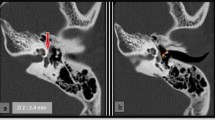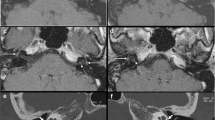Abstract
Purpose
Our aim was to evaluate the relationship of the dimensions of the facial canal (FC) and cochlear aqueduct (CA) in otosclerosis (OS) with the type and severity of OS.
Methods
Two radiologists retrospectively evaluated temporal bone high-resolution computed tomography (HRCT) images obtained from 48 healthy individuals and 94 OS patients between January 2015 and July 2020. In the study group, the CA width, funnel base width, and funnel length, in addition to the FC transverse length, were measured in the axial plane. The CA length was measured in the coronal plane on HRCT images. The FC craniocaudal length was measured in the same plane as the fissula ante fenestram (FAF) in coronal reformatted HRCT images. Grading of OS was based on otosclerotic plaque density and new bone formation extending toward the tympanic cavity at the FAF level.
Results
In the OS patients, the CA width and FC craniocaudal and FC transverse diameters were significantly decreased on both sides compared to those in the control group (p < 0.001). In fenestral OS, the FC craniocaudal and transverse widths on both sides were statistically significantly lower than the FC widths in the control group (p < 0.0001). A statistically negative correlation was found in the FC craniocaudal (r = − 0.831/− 0.818) and transverse (r = − 0.742/− 0.750) measurements on both sides in accordance with an increase in the otosclerotic plaque density (p < 0.0001).
Conclusion
The presence of narrowing in the FC and CA adjacent to the FAF supports the role of autoimmunity theory in the etiology of OS.



Similar content being viewed by others
Abbreviations
- CA:
-
Cochlear aqueduct
- FAF:
-
Fissula ante fenestram
- FC:
-
Facial nerve canal
- HRCT:
-
Temporal bone high-resolution computed tomography
- OS:
-
Otosclerosis
References
Markou K, Goudakos J (2009) An overview of the etiology of otosclerosis. Eur Arch Otorhinolaryngol 266:25–35. https://doi.org/10.1007/s00405-008-0790-x
Katherine L, Reinshagen, Kelly HR (2019) Otospongiosis. In: Small JE, Noujaim DL, Ginat DT, Kelly HR, Schaefer PW (eds) Neuroradiology, spectrum and evolution of disease, vol 47. Elsevier, Philadelphia, pp 363–368. ISBN 9780323445498
Moss WJ (2017) Measles. Lancet 390:2490–2502. https://doi.org/10.1016/S0140-6736(17)31463-0
Horner KC (2009) The effect of sex hormones on bone metabolism of the otic capsule an overview. Hear Res 252:56–60
McKenna MJ, Kristiansen AG, Bartley ML, Rogus JJ, Haines JL (1998) Association of COL1A1 and otosclerosis: evidence for a shared genetic etiology with mild osteogenesis imperfecta. Am J Otol 19:604–610
Karosi T, Szekanecz Z, Sziklai I (2009) Otosclerosis: an autoimmune disease? Autoimmun Rev 9:95–101. https://doi.org/10.1016/j.autrev.2009.03.009
Brown LA, Mocan BO, Redleaf MI (2019) Diagnostic protocol for detecting otosclerosis on high-resolution temporal bone CT. Ann Otol Rhinol Laryngol 128:1054–1060. https://doi.org/10.1177/0003489419859036
Akazawa Y, Ganaha A, Higa T, Kondo S, Oyakawa Y, Hirakawa H, Suzuki M, Yamashiro T (2020) Measurement of stapes footplate thickness in otosclerosis by ultra-high-resolution computed tomography. Acta Otolaryngol 140:899–903. https://doi.org/10.1080/00016489.2020.1788225
Dudau C, Salim F, Jiang D, Connor SE (2017) Diagnostic efficacy and therapeutic impact of computed tomography in the evaluation of clinically suspected otosclerosis. Eur Radiol 27:1195–1201. https://doi.org/10.1007/s00330-016-4446-8
Wegner I, van Waes AM, Bittermann AJ, Buitinck SH, Dekker CF, Kurk SA, Rados M, Grolman W (2015) A systematic review of the diagnostic value of CT imaging in diagnosing otosclerosis. Otol Neurotol 37:9–15. https://doi.org/10.1097/MAO.0000000000000924
Marx M, Lagleyre S, Escudé B, Demeslay J, Elhadi T, Deguine O, Fraysse B (2011) Correlations between CT scan findings and hearing thresholds in otosclerosis. Acta Otolaryngol 131:351–357. https://doi.org/10.3109/00016489.2010.549841
Kanzara T, Virk JS (2017) Diagnostic performance of high resolution computed tomography in otosclerosis. World J Clin Cases 5:286–291
Kutlar G, Koyuncu M, Elmali M, Basar F, Atmaca S (2014) Are computed tomography and densitometric measurements useful in otosclerosis with mixed hearing loss? A retrospective clinical study. Eur Arch Otorhinolaryngol 271:2421–2425. https://doi.org/10.1007/s00405-013-2729-0
Grayeli AB, Yrieix CS, Imauchi Y, Cyna-Gorse F, Ferrary E, Sterkers O (2004) Temporal bone density measurements using CT in otosclerosis. Acta Otolaryngol 124:1136–1140. https://doi.org/10.1080/00016480410018188
Kawase S, Naganawa S, Sone M, Ikeda M, Ishigaki T (2006) Relationship between CT densitometry with a slice thickness of 0.5 mm and audiometry in otosclerosis. Eur Radiol 16:1367–1373. https://doi.org/10.1007/s00330-005-0128-7
Yamashita K, Yoshiura T, Hiwatashi A, Togao O, Kikuchi K, Inoguchi T, Kumazawa S, Honda H (2014) The radiological diagnosis of fenestral otosclerosis: the utility of histogram analysis using multidetector row CT. Eur Arch Otorhinolaryngol 271:3277–3282. https://doi.org/10.1007/s00405-014-2933-6
Krombach GA, van den Boom M, Di Martino E, Schmitz-Rode T, Westhofen M, Prescher A, Günther RW, Wildberger JE (2005) Computed tomography of the inner ear: size of anatomical structures in the normal temporal bone and in the temporal bone of patients with Menière’s disease. Eur Radiol 15:1505–1513. https://doi.org/10.1007/s00330-005-2750-9
Wichova H, Alvi S, Boatright C, Ledbetter L, Staecker H, Lin J (2019) High-resolution computed tomography of the inner ear: effect of otosclerosis on cochlear aqueduct dimensions. Ann Otol Rhinol Laryngol 128:749–754. https://doi.org/10.1177/0003489419842579
Park JJ, Shen A, Keil S, Kraemer N, Westhofen M (2014) Radiological findings of the cochlear aqueduct in patients with Meniere’s disease using high-resolution CT and high-resolution MRI. Eur Arch Otorhinolaryngol 271:3325–3331. https://doi.org/10.1007/s00405-014-3199-8
Cheng HCS, Agrawal SK, Parnes LS (2018) Stapedectomy versus stapedotomy. Otolaryngol Clin North Am 51:375–392. https://doi.org/10.1016/j.otc.2017.11.008
Merati M, Kazemi MA, Dabiri S, Kouhi A (2020) Radiologic evaluation of the mastoid segment of the facial nerve tract in the intact temporal bone. Surg Radiol Anat. https://doi.org/10.1007/s00276-020-02554-z
Ho ML, Juliano A, Eisenberg RL, Moonis G (2015) Anatomy and pathology of the facial nerve. Am J Roentgenol 204:612–619. https://doi.org/10.2214/AJR.14.13444
Li T, Lai ZC, Wang XD, Feng Y, Li YQ, Fang XD (2013) Measurement and analysis of facial nerve on fully displayed multislice computed tomographic multiplanar reconstruction image. J Craniofac Surg 24:1411–1413. https://doi.org/10.1097/SCS.0b013e3182903673
Inal M, Bayar Muluk N, Asal N, Şahan MH, Şimşek G, Arıkan OK (2020) Does mastoid pneumatization affect facial canal dimensions and distances of facial tympanic segment-scutum and lateral semicircular canal-scutum? J Comput Assist Tomogr 44:380–385. https://doi.org/10.1097/RCT.0000000000000992
Funding
The authors declare that no grants or funds were received in this study.
Author information
Authors and Affiliations
Contributions
VC: conceptualization, methodology, validation, formal analysis, resources, investigation, writing—original draft, writing—review & editing, and supervision. PC: methodology, validation, formal analysis, resources, investigation, writing—review & editing, and supervision.
Corresponding author
Ethics declarations
Conflict of interest
The authors declare that no conflicts of interest and no grants or funds were received in this study.
Ethical approval
The study was approved by Ethics Committee of Faculty of Medicine, Pamukkale University (Number: PAÜ 60116787-020/59117).
Additional information
Publisher's Note
Springer Nature remains neutral with regard to jurisdictional claims in published maps and institutional affiliations.
Rights and permissions
About this article
Cite this article
Cakmak, V., Cakmak, P. Does otosclerosis affect the dimensions of the facial canal and cochlear aquaduct?. Eur Arch Otorhinolaryngol 278, 1845–1852 (2021). https://doi.org/10.1007/s00405-021-06655-2
Received:
Accepted:
Published:
Issue Date:
DOI: https://doi.org/10.1007/s00405-021-06655-2




